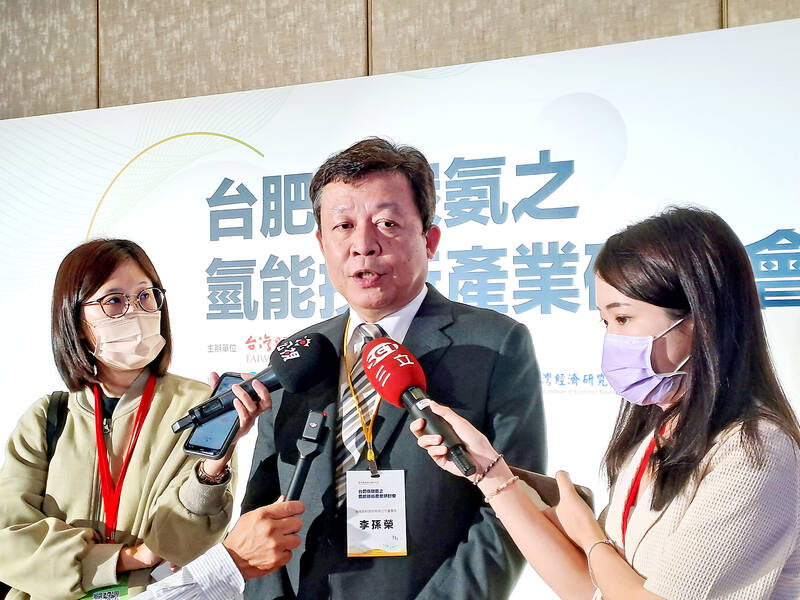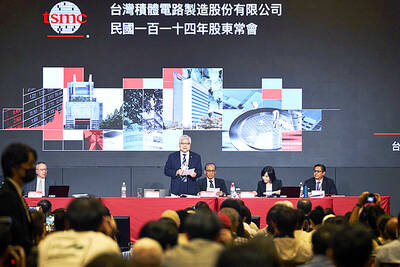Eyeing potential opportunities associated with low-carbon hydrogen, Taiwan Fertilizer Co (TFC, 台肥) is venturing into the clean energy sector by utilizing ammonia, an effective hydrogen energy carrier, TFC chairman Lee Suen-zone (李孫榮) said on Tuesday.
The company plans to construct two ammonia storage facilities over the next two to three years, Lee told an industrial seminar in Taipei.
Established in 1946, TFC is looking to transform its business to reduce carbon emissions in different ways, including a transition to clean energy using ammonia, traditionally a raw ingredient in fertilizer production, he said.

Photo: CNA
Lee also expounded on a technological breakthrough that would enable the company to use hydrogen and ammonia as renewable energy sources.
Ammonia is not only used for fertilizer production, but can also be used as an energy carrier and zero-carbon fuel, Lee said.
The chemical compound, made of hydrogen and nitrogen, does not emit carbon dioxide and can be mixed, or “cofired,” with coal at power plants to lower carbon emissions.
Ammonia can be directly broken down into hydrogen, making it a promising source of low-carbon energy, he said.
Low-carbon hydrogen includes green hydrogen (hydrogen produced from renewable electricity), blue hydrogen (hydrogen from fossil fuels using a process in which carbon emissions are reduced with the use of carbon capture and storage), and aqua hydrogen (hydrogen produced from fossil fuels via a new technology that does not emit carbon dioxide).
TFC currently has two ammonia storage facilities and plans to build two more in the next two to three years to meet the huge demand for ammonia as a low-carbon alternative to fossil fuels, Lee said.
The two existing ammonia storage tanks at the company’s Taichung plant have a total capacity of 40,000 tonnes per year and total annual shipments could reach 120,000 tonnes given a turnover ratio of three times per year, TFC acting president Chang Chang-lang (張滄郎) said.
The turnover ratio could still be raised to boost ammonia supply to the Taiwanese market, he added.
Developing hydrogen energy has become an important national goal, Lee said, adding that domestic hydrogen production is a better choice than importing it, because it can only be transported at an extremely low temperature, making importing difficult.
There is an emerging international consensus that a highly effective and cheap way to make hydrogen is through the conversion of ammonia, he said.
As the largest liquid ammonia supplier in Taiwan, TFC saw hydrogen development for the domestic clean energy market as a niche business and has invested in Al-Jubail Fertilizer Co, a joint venture with Saudi Basic Industries Corp in Saudi Arabia, to import ammonia from the country, Lee said.
Addressing the same seminar, Vice Premier Cheng Wen-tsan (鄭文燦) said he was upbeat about TFC’s ability to supply ammonia as a raw material for Taiwan Power Co (台電) to be cofired with coal, as a way of cutting carbon emissions.
Many countries around the world are developing hydrogen energy, one of the cleanest energy sources, as a substitute for oil and other fuels, he said, adding that as Taiwan moves toward the goal of net zero emissions by 2050, the establishment of a hydrogen supply chain is part of its hydrogen development strategy.

With an approval rating of just two percent, Peruvian President Dina Boluarte might be the world’s most unpopular leader, according to pollsters. Protests greeted her rise to power 29 months ago, and have marked her entire term — joined by assorted scandals, investigations, controversies and a surge in gang violence. The 63-year-old is the target of a dozen probes, including for her alleged failure to declare gifts of luxury jewels and watches, a scandal inevitably dubbed “Rolexgate.” She is also under the microscope for a two-week undeclared absence for nose surgery — which she insists was medical, not cosmetic — and is

CAUTIOUS RECOVERY: While the manufacturing sector returned to growth amid the US-China trade truce, firms remain wary as uncertainty clouds the outlook, the CIER said The local manufacturing sector returned to expansion last month, as the official purchasing managers’ index (PMI) rose 2.1 points to 51.0, driven by a temporary easing in US-China trade tensions, the Chung-Hua Institution for Economic Research (CIER, 中華經濟研究院) said yesterday. The PMI gauges the health of the manufacturing industry, with readings above 50 indicating expansion and those below 50 signaling contraction. “Firms are not as pessimistic as they were in April, but they remain far from optimistic,” CIER president Lien Hsien-ming (連賢明) said at a news conference. The full impact of US tariff decisions is unlikely to become clear until later this month

GROWING CONCERN: Some senior Trump administration officials opposed the UAE expansion over fears that another TSMC project could jeopardize its US investment Taiwan Semiconductor Manufacturing Co (TSMC, 台積電) is evaluating building an advanced production facility in the United Arab Emirates (UAE) and has discussed the possibility with officials in US President Donald Trump’s administration, people familiar with the matter said, in a potentially major bet on the Middle East that would only come to fruition with Washington’s approval. The company has had multiple meetings in the past few months with US Special Envoy to the Middle East Steve Witkoff and officials from MGX, an influential investment vehicle overseen by the UAE president’s brother, the people said. The conversations are a continuation of talks that

CHIP DUTIES: TSMC said it voiced its concerns to Washington about tariffs, telling the US commerce department that it wants ‘fair treatment’ to protect its competitiveness Taiwan Semiconductor Manufacturing Co (TSMC, 台積電) yesterday reiterated robust business prospects for this year as strong artificial intelligence (AI) chip demand from Nvidia Corp and other customers would absorb the impacts of US tariffs. “The impact of tariffs would be indirect, as the custom tax is the importers’ responsibility, not the exporters,” TSMC chairman and chief executive officer C.C. Wei (魏哲家) said at the chipmaker’s annual shareholders’ meeting in Hsinchu City. TSMC’s business could be affected if people become reluctant to buy electronics due to inflated prices, Wei said. In addition, the chipmaker has voiced its concern to the US Department of Commerce